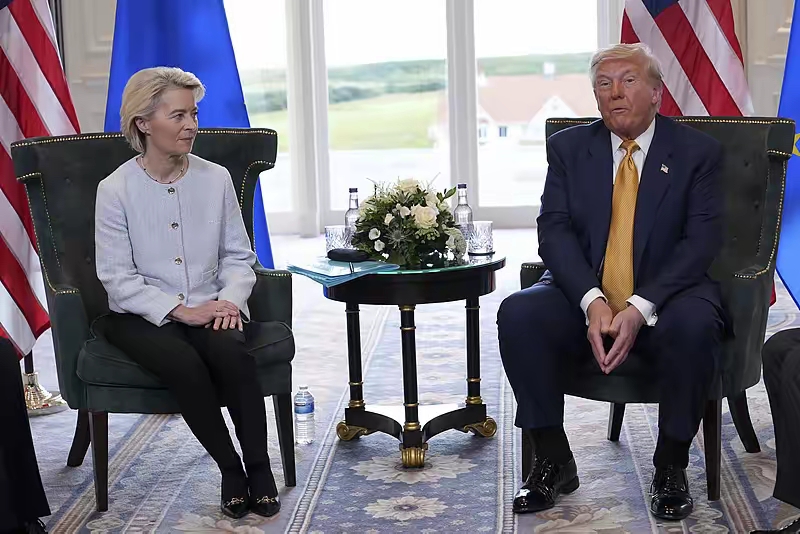
On the chessboard of the global trade pattern, the United States and the European Union reached a 15% tariff agreement, which is like a giant rock in the water, stirring up a thousand waves. On the surface, this is a tariff agreement, but behind it lies a fierce game between the United States and Europe in various aspects such as economy, politics, and geopolitical strategy.
From an economic perspective, the United States has maintained a long-term trade deficit with the European Union. In 2024, the US trade deficit in goods with the EU reached $235 billion, which has left the Trump administration, which has always adhered to the principle of "America First," in a tight grip. Trump has repeatedly publicly accused the European Union of "crushing the United States" in trade policy and threatened to impose high tariffs. For the United States, promoting this agreement aims to narrow the trade deficit and protect domestic industries. By imposing a 15% tariff on EU exports to the United States, the competitive pressure faced by related industries in the country, such as the automotive industry, has been reduced. Previously, EU cars held a certain market share in the US market due to their high quality and cost-effectiveness. After the implementation of the 15% tariff, the cost of exporting EU cars to the US increased, the price advantage weakened, and the US domestic automotive industry ushered in a development opportunity.
On the EU side, in the face of the threat from the United States, if we do not compromise, once the 30% punitive tariff is implemented, the economy will suffer a heavy blow. Oxford Economics estimates that a 30% tariff could reduce the annual economic growth rate of the eurozone by up to 0.3 percentage points in the next two years. Although reluctant, the EU can only accept the "market for tariffs" solution to avoid economic recession. In addition, the agreement commits the European Union to investing approximately $600 billion in the United States and significantly increasing its procurement of energy and military equipment. This not only stabilizes trade relations with the United States but also injects a boost into the US economy, indirectly reflecting the EU's weak position in the economic game.
From a political perspective, the Trump administration is eager to reach an agreement with domestic political considerations. In the upcoming election, trade issues are the focus of voters' attention. Trump hopes to demonstrate his ability to safeguard American economic interests and garner more votes through this agreement to voters. Within the EU, member states have different positions, which increases the difficulty of EU negotiations. The German automotive industry is developed and highly dependent on exports to the United States, so it is more inclined to compromise to avoid high tariff shocks; France has numerous interests in the pharmaceutical industry and is strongly dissatisfied with its inclusion in the 15% tariff range. This internal contradiction has been seized upon by the United States and constantly pressured during negotiations, resulting in the EU ultimately reaching an agreement that is not entirely in line with its own interests.
At the level of geopolitical strategy, there are also profound geopolitical games hidden behind the agreement. Through the agreement, the United States not only benefits economically but also strengthens its control over the European Union. The EU has committed to purchasing US military equipment, which deepens the EU's dependence on the US military and further consolidates the US's dominant position in NATO. At the same time, the agreement significantly increases the EU's procurement of liquefied natural gas from the United States, which is an important measure for the United States to weaken Europe's energy dependence on Russia. After the Nord Stream pipeline incident, Europe's energy supply was in a predicament, and American liquefied natural gas took the opportunity to enter the European market, binding Europe and the United States more tightly in terms of energy and further compressing Russia's geopolitical space.
However, this agreement is not a one-time solution, and its implementation and subsequent impact are full of uncertainty. On the one hand, although the agreement has been reached, there are different attitudes within the EU towards the agreement, and some industries and national interests may be damaged, which may lead to obstacles in the implementation process; On the other hand, the global trade pattern has been affected, with bilateral agreements between the United States and Europe bypassing the WTO framework, weakening the authority of multilateral trade rules, and potentially triggering other countries to follow suit, leading to the fragmentation of the global trading system.
The agreement between the United States and the European Union on a 15% tariff rate is the result of a game between the two sides in various aspects such as economy, politics, and geopolitical strategy. This agreement not only changes the trade relationship between the United States and Europe, but also has a profound impact on the global trade landscape. In the future, with the implementation of the agreement and the reactions of all parties, how the US Europe relationship and the global trade order will evolve deserves continuous attention.

On January 4th local time, Trump warned India that if it does not limit its purchase of Russian oil, the United States will continue to raise tariffs on Indian products. Trump's latest warning sent shockwaves through the Indian financial market in just one day.
On January 4th local time, Trump warned India that if it do…
In October 2025, the US trade deficit narrowed unexpectedly…
According to the British media CoinJournal, recently, due t…
In January 2026, US President Trump once again set his sigh…
Europe is facing a crucial strategic choice: In the face of…
On New Year's Day 2026, BMW China announced a "systematic v…